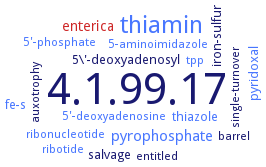4.1.99.17: phosphomethylpyrimidine synthase
This is an abbreviated version!
For detailed information about phosphomethylpyrimidine synthase, go to the full flat file.

Word Map on EC 4.1.99.17 
-
4.1.99.17
-
thiamin
-
pyrophosphate
-
enterica
-
5\'-deoxyadenosyl
-
thiazole
-
iron-sulfur
-
salvage
-
fe-s
-
pyridoxal
-
5'-phosphate
-
ribotide
-
barrel
-
auxotrophy
-
ribonucleotide
-
5'-deoxyadenosine
-
single-turnover
-
entitled
-
5-aminoimidazole
-
tpp
- 4.1.99.17
- thiamin
- pyrophosphate
- enterica
-
5\'-deoxyadenosyl
- thiazole
-
iron-sulfur
-
salvage
- fe-s
- pyridoxal
- 5'-phosphate
- ribotide
-
barrel
-
auxotrophy
- ribonucleotide
- 5'-deoxyadenosine
-
single-turnover
-
entitled
- 5-aminoimidazole
- tpp
Reaction
Synonyms
2-methyl-4-amino-5-hydroxymethylpyrimidine phosphate synthase, 4-amino-5-hydroxymethyl-2-methylpyrimidine phosphate synthase, AtTHIC, HMP phosphate synthase, HMP-P synthase, LeThiC, Thi5p, thiC
ECTree
Advanced search results
Cloned
Cloned on EC 4.1.99.17 - phosphomethylpyrimidine synthase
Please wait a moment until all data is loaded. This message will disappear when all data is loaded.
expression in Escherichia coli
gene thiC, archaeal ThiC is encoded by leaderless transcripts, ruling out a riboswitch mechanism. Instead, transcription factor ThiR, that harbors an N-terminal helix-turn-helix (HTH) DNA binding domain and C-terminal ThiN (TMP synthase) domain, is identified. In the presence of thiamine, ThiR represses the expression of thiC by a DNA operator sequence that is conserved across archaeal phyla. Sequence comparisons and genetic organization analysis
gene thiC, expression of His-tagged wild-type and mutant enzymes in Escherichia coli strain BL21AI, which also expresses Azotobacter vinelandii [Fe-S] cluster loading genes (iscSUA, hscBA, fdx, orf3, ndK)
-
gene thiC, overexpression of His6-tagged enzyme from vector pET-28b(+) in a Azotobacter vinelandii strain overexpressing [Fe-S] cluster-loading genes from plasmid pDB1282
-
gene thiC, recombinant expression of His-tagged N-terminally truncated mutant DELTAN71-AtTHIC in Escherichia coli strain BL21(DE3)
gene YFL058w, recombinant expression of GST-tagged enzyme mutant in Salmonella enterica strain LT2, one mechanism to allow Thi5p function in Salmonella enterica is by remodeling the metabolic network associated with the sugar phosphate stress response regulator, transcription factor SgrR (formerly YabN), integration between the sugar-phosphate stress response regulator and Thi5p activity in Salmonella enterica. SgrR belongs to a distinct class of transcription regulators (COG4533) and has a predicted N-terminal DNA-binding domain and C-terminal solute-binding domain, expression from the sgrS promoter (sgrSp) is used as a reporter of SgrR activity. Thi5p must be activated in order to function in Salmonella enterica, possibly by phosphorylation or another posttranslational modification
heterologous expression of AtTHIC can functionally complement the thiC knock-out mutant of Escherichia coli
LeThiC under the control of the cauliflower mosaic virus 35S promoter is introduced into the tl mutant by Agrobacterium tumefaciens-mediated transformation. Expression of the wild-type LeThiC gene in the tl mutant is able to complement the mutant to wild type
expression in Escherichia coli


 results (
results ( results (
results ( top
top





